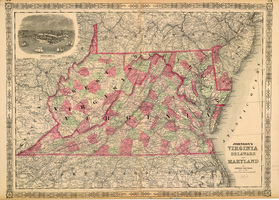 | Back to e-WV
| Back to e-WV
 The West Virginia Encyclopedia
The West Virginia Encyclopedia
 | Back to e-WV
| Back to e-WV
 The West Virginia Encyclopedia
The West Virginia Encyclopedia

The First Wheeling Convention called upon counties to elect representatives to a succeeding convention if Virginia voters approved the Ordinance of Secession on May 23, 1861. After a majority of voters did so, regular and irregular Confederate forces began operating in western Virginia. This Second Wheeling Convention met June 11-25, 1861, and again August 6-21.
On May 26, 1861, General George B. McClellan moved his troops to western Virginia to counter Confederate efforts to control the Baltimore & Ohio Railroad and to preserve western Virginia for the Union. The presence of McClellan’s Union forces aided the election of representatives to the Second Wheeling Convention in the face of increasing hostility from southern troops and southern sympathizers. Despite the presence of Union troops, however, not all elections could be held. Some delegates were chosen irregularly, while some were self-appointed.
One hundred delegates representing 34 counties met in Wheeling June 11, 1861. While these counties were mostly western counties, the composition was not entirely geographic. The delegates included representatives of the city of Alexandria and Fairfax, Hardy, Hampshire and Jefferson counties from east of the Allegheny Mountains, while 15 of the 44 counties of western Virginia were not represented. The 15 absent counties included almost all of present southern West Virginia, plus a few contiguous counties of present southeastern and central West Virginia.
Sentiment for creating a new state was strong, but the convention adopted a Declaration of Rights of the People of Virginia which included a call for the reorganization of Virginia as a state loyal to the United States. Some delegates, such as John S. Carlile, were initially in favor of creating a new state during the First Wheeling Convention but amended their positions and agreed with those who maintained that immediately declaring a new state did not meet the requirements set forth in the U.S. Constitution. On June 19, 1861, the convention adopted an ordinance to reorganize Virginia as a loyal state, and on June 20, 1861, delegates elected Francis H. Pierpont as the governor of Virginia. Governor Pierpont called the legislature of the Reorganized (also called Restored) Government into session on July 1, 1861.
The Second Wheeling Convention adjourned on June 25, 1861, to reconvene on August 6. After the formation of the Reorganized Government of Virginia, some of the delegates believed that it was preferable to continue Virginia in its pre-war entirety rather than create a new state out of the western counties. But on August 20, after lengthy debate, the convention adopted an “Ordinance to Provide for the Formation of a New State out of a Portion of the Territory of this State” and set October 24, 1861, for a referendum by the voters. The ordinance further provided that the voters would elect representatives to a constitutional convention (set for November 26, 1861) which would convene if the creation of a separate state was approved in the October 24 vote.
Its work done, the Second Wheeling Convention adjourned sine die on August 21, 1861.
Written by Kenneth R. Bailey
Ambler, Charles H. & Festus P. Summers. West Virginia: The Mountain State. Englewood Cliffs, NJ: Prentice-Hall, 1958.
Curry, Richard O. A House Divided: Statehood Politics & the Copperhead Movement in West Virginia. Pittsburgh: University of Pittsburgh Press, 1964.
Rice, Otis K. West Virginia: A History. Lexington: University Press of Kentucky, 1985.